In Fire Officer’s Handbook of Tactics, John Norman begins his chapter on private dwellings by recommending the following scenario for operations in these occupancies1:
- Secure the water supply.
- Stretch a charged hoseline into position to protect the bedroom exits.
- Perform vent-enter-search of all areas.
- Extinguish the fire.
These best practices, exceptions notwithstanding, could not be more simply stated. They have stood the test of time, and they are now more important than ever. Fire propagation is occurring exponentially faster and construction features allow significant volumes of fire on the exterior and in attic spaces to threaten occupied areas with little warning. Modern practices in home energy efficiency add to fire loading and conceal products of combustion, bringing new emphasis to the adage, “Nothing showing means nothing.” Beyond this, we also have a better understanding of wind-driven fires and their deadly consequences. On the upside, we now have scientific evidence on the viability of spaces behind closed doors, and data from the Firefighter Rescue Survey is giving us tremendous insight into when, where, and how we rescue fire victims.
RELATED FIREFIGHTER TRAINING
Water Supply Tactics: Expect the Unexpected
Overcoming an Insufficient Water Supply
Rural Connections: Water Supply
Because of all this, we must have an even sharper focus on our initial incident priorities. We must set up our procedures to be simple, reliable, and versatile throughout a range of possibilities, and we must dial in our equipment and training to execute these basic functions as quickly and efficiently as possible. Furthermore, we cannot get lulled into a false sense of operational success based on the outcome of routine fires: The outliers, where conditions don’t follow our rules, are the ones that get us into trouble. Just because something works well most of the time does not mean it won’t yield disastrous results given the right set of conditions.
Securing Your Supply
Securing a water supply—the first item in Norman’s scenario for private dwelling fires—is one of those practices we must optimize while supporting rapid deployment of the first attack line. Most structure fires are knocked down with tank water, which is quick and easy, but failure to take initial steps to secure a water supply early in the incident is a vulnerability that has led to the deterioration of many firegrounds. Norman’s approach fully recognizes this, stating, “The odds are that the fire will be all but fully extinguished long before a 500-gallon tank runs out. Nonetheless, you must be prepared for the 1 percent of fires that don’t go out with 500 gallons.”1
We are professionals; running out of water should not be considered acceptable if we could have taken steps to prevent it. In “Blowing the Basics,” Chief Tom Brennan wrote, “Running out of water is the same as encountering a burst hose immediately after starting water! The change in strategy inside the structure and the scuffle outside the structure create a delay that is insurmountable! If delay in water supply is an internal problem, it is a disgrace. If it is because of poor staffing or response policy, it should be broadcast in all its ramifications.”2

(1) Any fire attack plan should emphasize rapid placement of the first line and occupation of the interior with aggressive primary searches while taking efficient initial steps to guarantee a water supply. (Photo by Lloyd Mitchell.)
To combat the loss of water and ensure overall operational success, some of the most aggressive departments in the country practice having the first-arriving engine place hose between themselves and the water source. In some areas, this is best accomplished with a reverse lay or “back stretch,” or an engine company may have its own hydrant or reach one with a short hand stretch. However, in many more settings, it will entail a forward lay on that first engine’s approach.
To emphasize rapid placement of the first handline, this need not involve placing a firefighter at the hydrant, just dropping the supply line and hastening to the scene, where the crew goes to work on tank water. The driver works to support handline deployment, not pivoting to address his supply line until the attack line is in place and operating. The driver of the second engine will routinely send water from the hydrant, but otherwise anyone can perform this task and, thus, the first engine has guaranteed its own water supply.
Having confidence in our water supply enables us to operate more aggressively, taking on more risk and pushing ourselves further because we are not wondering if the engine is about to run out of water. A well-executed forward lay operation is not a detraction from our ability to protect civilian life. It is an enhancement.
Applying Water Efficiently
In the fire service, our objective is to minimize the time from alarm receipt to effective water application and occupation of the building. There are countless ways to contribute to this effort, and some make more sense than others. It is our job to decide what matters and then to make those components as efficient as possible. As such, it is imperative that the layout process itself be given its due. Where equipped, hosebed netting should have a quick-release design, and hydrant equipment should be kept to the essentials, packaged neatly, and located at the tailboard. Layout straps can aid in a quick deployment of the supply line and be dropped over the hydrant rather than wrapping it. Most importantly, departments must practice the layout process repeatedly: Drivers must have their approach and “spotting” down pat, and the member laying out—either the driver or a backstep firefighter—must rehearse each step so that there are no wasted movements. Much like the process of masking up, the layout process is a fundamental procedure that we can’t afford to ignore after the fire academy. And, like masking up, a poor setup and an unpracticed member may take a minute to complete this operation. However, by understanding that unnecessary time spent on either of those is time that stands between us and making entry into the fire building, we can improve on both through better setups and practice until each of them takes 15 to 20 seconds or less. There are motivated companies that have streamlined their net layout time to less than 10 seconds. Poor performance is not a valid reason to skip over a critical function; it is a reason to double down and take responsibility for improvement by whatever means necessary.
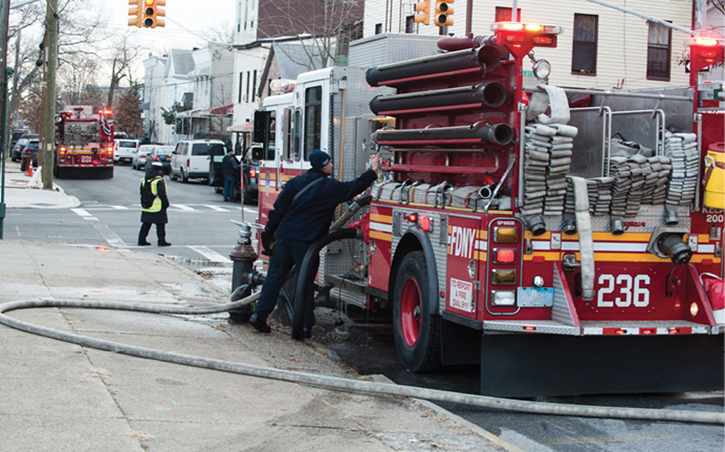
(2) In some settings, the backstretch (reverse lay) will be the best choice for water supply, or an engine company may have its own hydrant or be able to reach one with a short hand stretch. (Photo by Lloyd Mitchell.)

(3) Some of the busiest and most aggressive departments in the country use a fast and efficient forward lay by the first engine company to guarantee a water supply, streamline operations, and provide tactical flexibility. (Photo by Jason Coleman-Cobb.)
Why is it so important to put hose in the street? A look at data from the Underwriters Laboratories Firefighter Safety Research Institute (UL FSRI) Study of Coordinated Fire Attack Utilizing Acquired Structures shows that one- and two-room fires in single-family dwellings were controlled with 250 gallons of water or less.3 However, given that fire conditions are less evident than ever before, how can we judge the extent of fire involvement from half a block away? The data from these studies is extraordinarily valuable, but we must take it for what it is; it is not, nor does it pretend to be, representative of all the real-world variables that require greater water consumption for suppression. Shielded fires, heavy clutter conditions, wind-impacted conditions, fires in void spaces, fires involving several rooms or multiple floors, fires in attached structures, and significant exterior-origin fires are just a handful of such real-world conditions that may require substantially more water for extinguishment. Water applied at the right rate and properly mapped minimizes the total volume required, but the fireground is an imperfect world, and we need to expect that conditions can preclude our ability to do so. No matter how skillful we are, we don’t get to choose the conditions in which we have to operate.
In the future, there may be scientific studies conducted on more of these variables, but right now we must consider scientific data tempered by fireground experience—an approach that those in the research community apply constantly to guide and strengthen their work. When some of the early studies were published, there were those in the fire service who rushed to the single-minded conclusion that transitional attack was always the best thing for victims because of the speed of water application and, therefore, should act as the default approach. Others knew that this viewpoint was extremely narrow and that many additional factors affect victim survivability and tactics were situation dependent. Now, with more comprehensive studies completed by UL FSRI, we have data to confirm the many benefits of interior fire attack and, in particular, the flow-and-move technique. In much the same way, we must view the residential fire water usage data in the context of the study.
That said, there is data from UL FSRI that provides an example of the importance of water supply and considering the outliers. In its Analysis of the Coordination of Suppression and Ventilation in Multi-Family Dwellings study, most fires were extinguished with minimal amounts of water. However, in Experiment #5, a shielded belowgrade fire required 1,543 gallons of water for fire attack.4 This attack required the interior crew, advancing against the flow path, to flow water continuously to beat back the products of combustion while an exterior stream was placed into operation to darken down the fire and enable the interior advance. A case such as this cannot be dismissed as an oddity or a mistake. The truth is that this is exactly the sort of scenario that fire departments will encounter in real life. Should an engine company run out of water while making an interior advance, depending on its stream to hold back fire, the outcome could result in multiple line-of-duty deaths (LODDs), secondary to extreme thermal exposure.
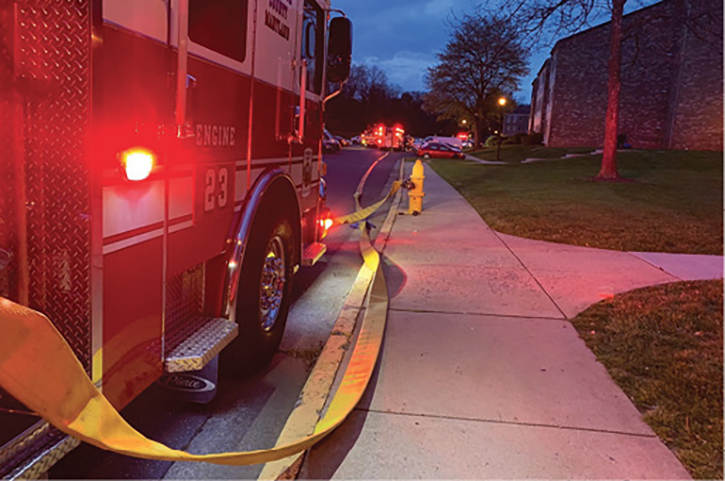
(4) Products of combustion are more concealed today than ever before. Decisions based on the conditions visible on approach are unreliable. (Photo by Jason Huntington.)
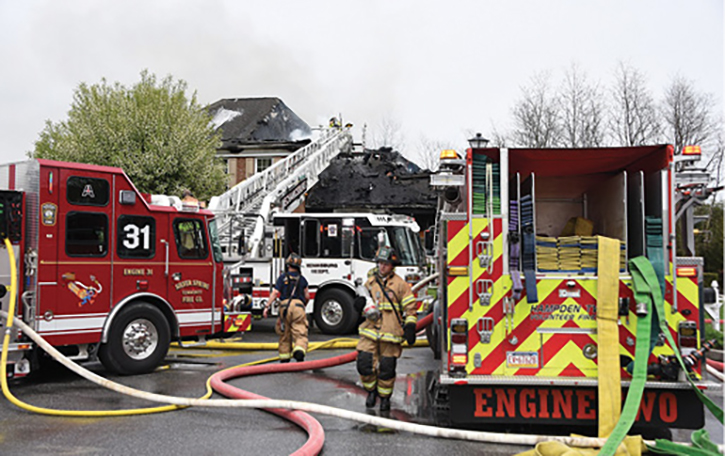
(5) A forward lay by the first-arriving engine builds in contingencies and ensures a water supply regardless of the fire volume encountered. (Photo by Jason Coleman-Cobb.)

(6) When a continuous water flow is what’s necessary for maintaining and expanding a survivable space while supporting searches, we must be able to ensure exactly that. Running out of water is not an acceptable option. (Photo by Lloyd Mitchell.)
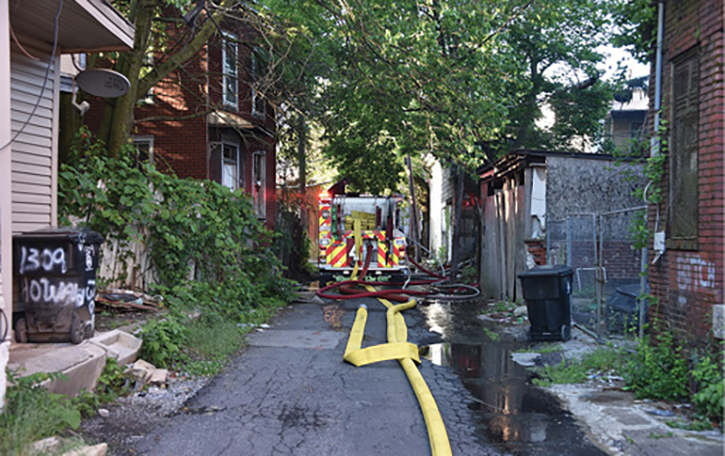
(7) Setting up your water supply evolutions to require the fewest engine companies allows for tactical flexibility. Without being otherwise constrained, the third and fourth engines are available to establish a secondary water supply and take alternate positions such as a rear alleyway or other C-side access. (Photo by Jason Coleman-Cobb.)
Other Incident Types
Another incident type that can require early high-flow water application is exterior-origin fires, which are becoming more common and result in greater consequence. Perhaps no other incident is better known involving this type of fire than the 2007 fire that killed Prince William County (VA) Technician Kyle Wilson.5 Crews arrived to a large, new-construction home with substantial fire conditions involving the back deck and the entire three-story rear exterior of the structure, extending into the attic. At 0608 hours, with cars in the driveway and no one to meet them outside, crews had every indication there would be victims trapped—and indeed there might have been. On initial entry, conditions on the residence’s first and second floors were tenable and mostly clear. However, with high winds driving the fire through the attic space of the “McMansion”-style house, conditions deteriorated in a matter of seconds, ultimately leading to Wilson’s entrapment and LODD.
Today, we have the benefit of UL FSRI research to help us understand the dynamics of these fires. We now know that, when faced with a substantial exterior-origin fire that is running into the attic, the only approach is to create and maintain tenable interior conditions for civilians and firefighters alike by rapidly deploying exterior streams capable of knocking down the main body of fire, followed immediately by advancing lines to the interior. For conditions dictating large-caliber streams, a 250- to 330-gallon-per-minute flow rate will provide the typical suburban engine company with two to three minutes of water when the fire does not immediately darken down. In all but the most resource-dense departments, the only way to sustain the water supply to enable such an attack and leverage interior occupation is for the first-arriving engine to have laid its own supply line on the way in. In the case of Prince William County, companies did that and had established primary and secondary water supplies early in the incident.
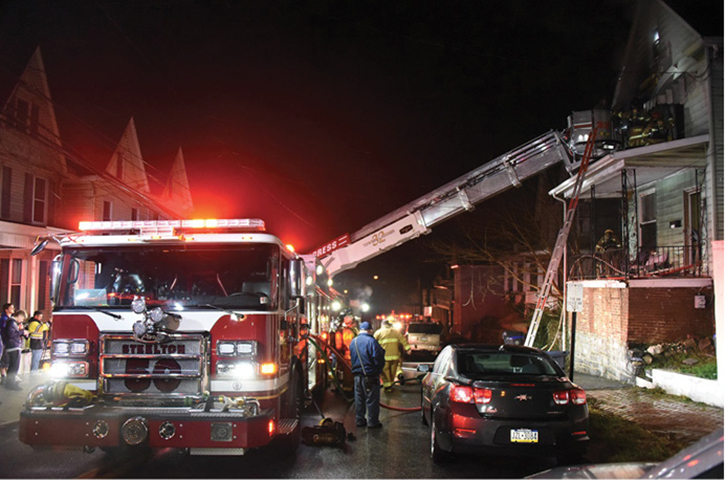
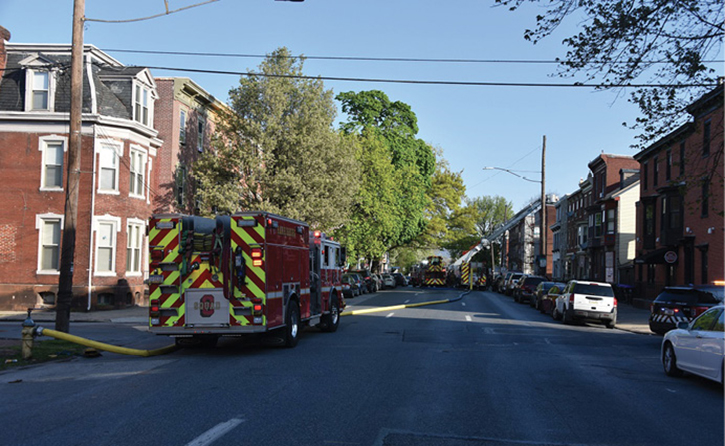
(8, 9) Requiring only one engine to commit to the area of the fire building early on minimizes congestion and allows access to position aerial devices advantageously. (Photos by Jason Coleman-Cobb.)
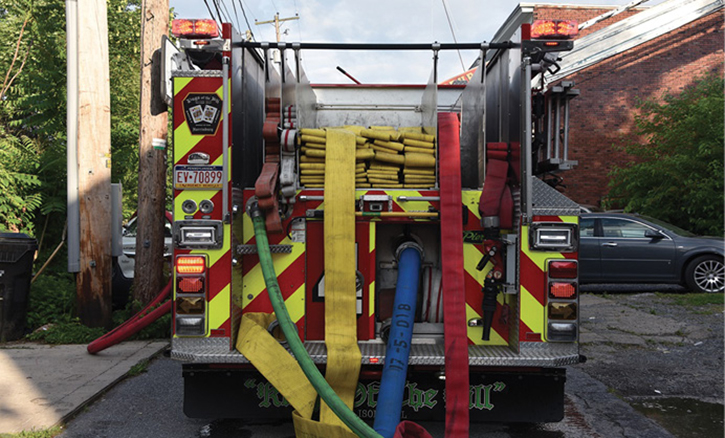
(10) Having the first engine lay out from the hydrant is the simplest approach that offers operational consistency and performance. (Photo by Jason Coleman-Cobb.)
Water Supply Strategies
In any discussion of water supply strategies, you must consider your department’s operational realities. As noted above, to sustain a 2½-inch handline, a department that plans on a two- or three-engine approach to water supply must be able to guarantee that the second engine will arrive 1½ to three minutes after the first and, subsequently, the third engine within 1½ to three minutes after that; this must account for nearby companies being tied up on calls, inclement weather conditions, or the possibility of a collision or mechanical failure. Most of this country’s fire departments do not have such resource density and would only be waiting for their luck to run out if they chose to adopt this type of strategy.
When conditions are favorable, you may only need to operate the large-caliber stream briefly, but at other times, this is not the case. Even a single 1¾-inch line flowing continuously on a well-involved fire will deplete tank water in three to five minutes—a time frame that is borderline for engine company spacing in many areas. Recent data out of the Firefighter Rescue Survey shows that 30 percent of victims are rescued when the fire is involving structural members, and those victims have a 46 percent survival rate.6 In instances where that continuous flow is what’s necessary for maintaining and expanding survivable space for potential victims, we must ensure exactly that. Requiring your operational success to hinge on the arrival of three engine companies in rapid succession while supplementing with tank water can be like a team log rolling competition: You can work frantically and keep it going—until you can’t. Resources and response area will factor heavily into how realistic this approach will be for a given department as well as the possible consequences of failure.
However, even for departments fortunate enough to have that sort of resource density, depending on three engines to complete a supply evolution constrains your tactical deployment options. In the mid-Atlantic region, it is common practice to have first-alarm companies take mirrored positions on the fireground: two engines and a truck to the front of the building and two engines and a truck to the rear. By having the first engine to each side lay its own supply, the second engine to each position can pick up the first engine’s line at the hydrant and complete the supply, pumping the hydrant as necessary. The March 2014 fire in Boston’s Back Bay neighborhood, which claimed the lives of Lieutenant Ed Walsh and Firefighter Michael Kennedy, illustrated the importance of having the routine flexibility for units to take positions at both the front and rear.7 This wind-driven basement fire in a brownstone rowhouse required determined firefighters on multiple 2½-inch hoselines deployed from the C side to make entry to the basement.
The old-fashioned model of two- or three-piece fire companies provided the luxury of a piece going directly to the fire to initiate attack while other pieces completed the water supply. The important difference here is that the pieces were married and responding out of the same house, so it eliminated the variables of subsequent unit arrival times, thereby ensuring a water supply without delay. With today’s “triple combination” engine companies, each unit is just that—a separate company spaced throughout a response area, with the resulting staggered arrival times and no guarantee of a continuous water supply. Efficient use of the hose and the tank water of our triple combination pumpers is the optimal use of these resources in the modern first-due setting.
Having the first engine lay out from the hydrant is the simplest approach that offers operational consistency and performance. It builds in critical contingencies and requires dependence on the fewest number of companies, reducing the coordination needed and creating greater reliability. A clear standard operating guideline that details how the first engine will lay out reduces poor decision making from lack of information and the reality of human factors. It does not congest the front of the fire building unnecessarily with additional engine companies and instead leaves the area open for aerial positioning. For example, on tight streets, having a second engine proceed to the scene prior to the arrival of the first truck company can block out an aerial device entirely. If a frozen hydrant is encountered, the second engine will be in a reasonable position to reverse back from that point to the next hydrant down the street.
In the rural setting, driveway length, tank capacity, and supply hose size may force the second engine or tanker to take the driveway. If that unit is so equipped, it is reasonable for it to lay the supply line. However, for shorter driveways, it will yield greater operational flexibility for the first engine to lay out and keep units for water supply at the road. Keeping large-diameter hose in the center or to one side of the driveway allows access for an aerial device at the fire building.
Our mission is to save lives first and foremost and then to save property. We must prioritize getting companies into operation quickly to support this mission, but we must also ensure they don’t run out of the water they need to accomplish it. If we run out of water at the time that we need it most, everyone will suffer, and we will fail to accomplish our mission on multiple levels. Streamline your equipment and drill relentlessly until you can consistently perform the layout process in 15 to 20 seconds or less. By doing this, you can meet all of your goals and provide the greatest performance for the civilians we are sworn to protect. We can meet the needs of the “majority” fires while including the tactical flexibility needed for decisive wins in the face of adverse conditions. As with all of our operations, it starts with an expectation of performance that is grounded in sound tactics.
References
1. Norman J. (2012). Fire Officer’s Handbook of Tactics (4th ed.). Tulsa, OK: PennWell Corporation.
2. Brennan T. (2007). Tom Brennan’s Random Thoughts. Tulsa, OK: PennWell Corporation.
3. Regan J, Bryant J, Weinschenk C. (March 19, 2020). Analysis of the Coordination of Suppression and Ventilation in Single-Family Homes. Columbia, MD: Underwriters Laboratories. https://ulfirefightersafety.org/docs/Coord_Tactics_Single_Family_Homes.pdf.
4. Stakes K, Bryant J, Dow N, et al. (June 23 2020). Analysis of the Coordination of Suppression and Ventilation in Multi-Family Dwellings. Columbia, MD: Underwriters Laboratories. https://ulfirefightersafety.org/docs/Coord_Tactics_Multi_Family.pdf.
5. National Institute for Occupational Safety and Health. (May 16, 2008). Career Fire Fighter Dies in Wind Driven Residential Structure Fire —Virginia. Cincinnati, OH: Fire Fighter Fatality Investigation and Prevention Program. https://www.cdc.gov/niosh/fire/pdfs/face200712.pdf.
6. Firefighter Rescue Survey and Ledin, N. (May 18, 2021). Fire Conditions Upon Entry v Survival Rate. Firefighter Rescue Survey Rescues Group.
7. National Institute for Occupational Safety and Health. (March 2, 2016). Lieutenant and Fire Fighter Die and 13 Fire Fighters injured in a Wind-driven Fire in a Brownstone—Massachusetts. Cincinnati, OH: Fire Fighter Fatality Investigation and Prevention Program. https://www.cdc.gov/niosh/fire/pdfs/face201409.pdf.
CALEB LANGER is a 21-year fire service veteran who has worked in both combination and career fire departments. He serves as training officer and captain with the Northampton (MA) Fire Rescue Department.

